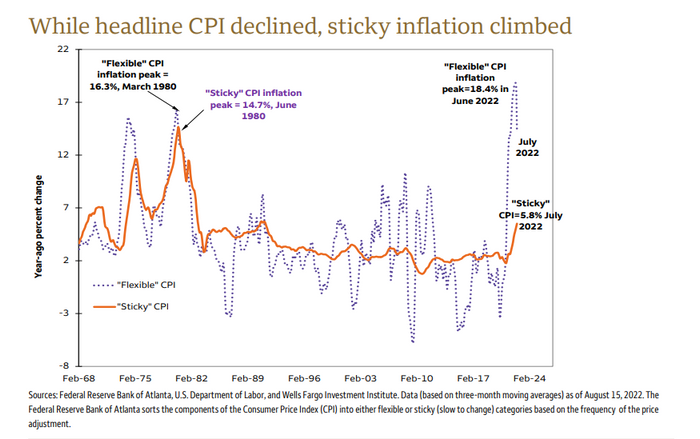Don’t underestimate the power of surging rents and other “sticky” sources of inflation to complicate the Federal Reserve’s inflation fight.
Sticky inflation, from high rents to climbing medical costs, have been on the rise in America, hitting 5.8% in July (see chart), even through food, fuel and other “flexible” components of the consumer-price index fell from a high of 18.4% in June, according to the Wells Fargo Investment Institute.

The type of inflation that tends to stick around is rising, posing a risk for investors.
Wells Fargo Investment Institute, Federal Reserve
Sticky inflation like apartment rents tend to change less frequently than once every 4.3 months, according to the Wells team, while flexible prices change more quickly.
Despite positive signs lately, the Wells team warned in a Tuesday client note that inflation could be in “for a bumpy ride” in the coming months, “whipsawed by swings in volatile food and energy costs, along with softening demand for goods.”
They also expect “added pressure” from rents and wage-sensitive service prices, and expect the consumer-price index to end 2022 at 7.7%, before slowing to 3.5% by the end of next year. That still would be well above the Fed’s 2% target.
Related: Why home prices can stay high, complicating the Fed’s battle against inflation
Jobs in focus
On the wage front, Luke Bartholomew, senior economist at abrdn, said in emailed comments Tuesday that while many investors have been “asking themselves if the Fed can cool the labor market without pushing unemployment up, the truth is this outcome would require firms to hire less, rather than lay off workers.
“It’s more likely that that rising unemployment will, unfortunately, be required to stem labor-market pressures.”
Stocks sharply rallied this summer after the July consumer-price index surprised to the downside, showing a slower, 8.5% annual pace of inflation than the month before. Hopes that slower inflation might prompt a “dovish” Fed pivot away from aggressive rate hikes helped fuel the bullish move, with the S&P 500 climbing about 17% from its mid-June low, before stocks hit turbulence in recent sessions.
The S&P 500 index SPX, -0.22% and Dow Jones Industrial Average DJIA, -0.47% ended lower Tuesday for a third straight session, a day after both booked their worst daily plunge in about two months. The 10-year Treasury yield TMUBMUSD10Y, 3.055% has reclaimed the 3% mark, a level known for adding pressure to stocks.
Friday will bring an update on the Fed’s preferred inflation gauge, the personal-consumption price index, which climbed to 6.8% in June, its highest rate since January 1982.
Investors also remained focused on what Fed Chairman Jerome Powell might say Friday in his Jackson Hole, Wyo., speech about high costs of living and the U.S. economy.
See: Why Fed Chair Powell may not be ‘overly hawkish’ at Jackson Hole, according to this JPMorgan portfolio manager and Get used to aggressive rate hikes and stop counting on a ‘dovish’ Fed pivot, market pros warn










Add Comment